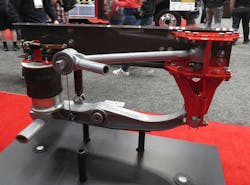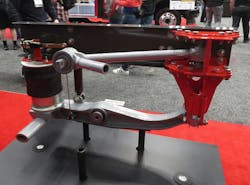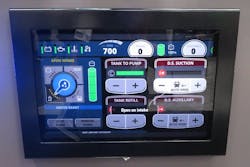Backlogs at apparatus manufacturers still are causing extraordinarily long lead times. Rightly, manufacturers have concentrated on reducing the backlogs and improving delivery times, not on new rigs, generally.
On the other hand, product development programs that are in place at apparatus component and system suppliers seemingly are unhindered. In particular, four innovations that were on display at FDIC 2025 seem destined to put apparatus drivers and firefighters in better, safer circumstances.
Chassis-movement decrease
After extensive research into certain fire departments’ problems with rear suspensions, Link Manufacturing developed the RespondAir heavy-duty air ride suspension. Designed specifically for fire apparatus, it’s available in single-axle (weight ratings of 30,000–35,000 lbs.) and tandem-axle (60,000–70,000 lbs.) configurations.
The RespondAir suspension is designed to be nontorque reactive, to reduce chassis movement during acceleration and braking.
The suspension’s V-Rod design provides greater lateral stability and reduces tail swing. The latter is a particularly useful feature on apparatus that have a long rear overhang.
The air system’s rapid-dump feature reduces an apparatus’ overall height, to make fitting vehicles into older firehouses that have a short bay door height easier. (Note: Always discuss this feature with your apparatus manufacturer’s engineers, because several variables must be considered when the system is discussed.)
Larger bushings than those that might be used on other suspensions distribute stress over an increased surface area to reduce maintenance and to lengthen service life, the company says. The RespondAir suspension is compatible with Dana and Meritor rear axle assemblies.
Pump control configuration
Fire Research’s ACE (Advanced Control Environment) multiplexed pumping system provides real-time control and automation of the fire pump, the company says.
Although the system (see photo on page 30) doesn’t replace the pump operator nor enable pump operators to leave their post, it allows departments to configure pump controls based on their operational needs. This streamlines pump operations and provides high levels of scalability and flexibility.
The ACE system can integrate a variety of valves, automate specific functions and enable full manual control of the pump. Furthermore, it protects against overheating, pump cavitation (formation and rapid collapse of vapor bubbles in a liquid) and pressure surges and can be used to manage discharge pressures, drafting and switching water sources. The goal is to improve safety and efficiency while protecting the pump.
Stream targeting
HEN Nozzles applied its blade capabilities to the newly designed Titan 1250 deck gun and Titan 500 turret.
The open piping and electrical wires that typically are seen on master stream devices are built into the housing on these units, including about six inches of visible wiring to connect to the nozzle stream adjustment. The deck gun has an option to include a 2½-inch Turbo in-line throttling valve that allows the operator to adjust stream reach remotely or manually. According to the company, this modulates flow for varying distances, to allow an operator to target the stream without altering the deck gun elevation.
The deck gun and the turret are fully electrically operated, with built-in manual controls. The deck gun and allows 1,250 gpm. The 500-gpm turret mimics the deck gun in design and function.
Also, the company is developing blade deck gun nozzles that will be compatible with existing manual and electric deck guns.
Handwheel valve controller
Innovative Controls is developing a new handwheel valve controller that will deliver a number of inventive design features.
Smaller than that to which the fire service is accustomed, the controller will require less pump panel space. It will actuate either a cable or linkage that’s attached to the valve swing handle. Rotating the handwheel will retract or extend the linkage or cable, to open and close valves. By contrast, other handwheel actuators utilize a gear box that’s mounted on the valve.
Built into the bezel assembly across the top will be eight LED indicators that show valve status: They display red when a valve is closed and green when it’s open. Although the indicators change their status one at a time, each pair will indicate one quarter of the valve’s movement. For example, two green lights will indicate that the valve is open 25 percent, four green lights will indicate that the valve is half open, and so forth.
About the Author

Jeffrey D. Gaskin
Jeffrey D. Gaskin is president of Big Red Trucks Fire Apparatus Consultants. He is a retired captain from the Scarsdale, NY, Fire Department. Throughout his career, Gaskin has been involved in apparatus acquisitions, from needs assessment through specification-writing. He also is a fire apparatus mechanic and holds certifications from Allison Transmission, Detroit Diesel, Hale Pump, Smart Power, Spartan Chassis, Sutphen Fire Apparatus and others. Gaskin is certified by the Emergency Vehicle Technician Certification Commission in six areas: Fire Apparatus Inspection, Maintenance and Testing (F-1); Design and Performance Standards of Fire Apparatus (F-2); Fire Pumps and Accessories (F-3); Aerial Fire Apparatus (F-5); Allison Automatic Transmission (F-6); and Hydraulic Systems (F-8). He can be reached at [email protected].



